
Wooden synagogues of Eastern Europe
Encyclopedia
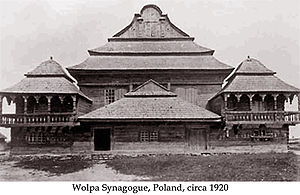
Synagogue architecture
Synagogue architecture often follows styles in vogue at the place and time of construction. There is no set blueprint for synagogues and the architectural shapes and interior designs of synagogues vary greatly. According to tradition, the Divine Presence can be found wherever there is a minyan,...
that developed in the Polish-Lithuanian commonwealth
Polish-Lithuanian Commonwealth
The Polish–Lithuanian Commonwealth was a dualistic state of Poland and Lithuania ruled by a common monarch. It was the largest and one of the most populous countries of 16th- and 17th‑century Europe with some and a multi-ethnic population of 11 million at its peak in the early 17th century...
.
Uniqueness as an artistic and architectural form
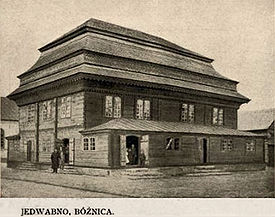
Bimah
A bimah A bimah A bimah (among Ashkenazim, derived from Hebrew בּמה , almemar (from Arabic al-minbar) or tebah (among Sephardim) is the elevated area or platform in a Jewish synagogue which is intended to serve the place where the person reading aloud from the Torah stands during the Torah reading...
rise to support the roof vaulting. Central pillars support the vaulting of only a handful of wooden synagogues. Instead, in wooden synagogues the vaulting and domes are suspended by elaborate roof truss
Truss
In architecture and structural engineering, a truss is a structure comprising one or more triangular units constructed with straight members whose ends are connected at joints referred to as nodes. External forces and reactions to those forces are considered to act only at the nodes and result in...
es. Common features shared by wooden synagogues include the independence of the pitched roof from the design of the interior domed ceiling. The outside of a wooden synagogue gave no hint of the domes and multiple, Baroque
Baroque
The Baroque is a period and the style that used exaggerated motion and clear, easily interpreted detail to produce drama, tension, exuberance, and grandeur in sculpture, painting, literature, dance, and music...
vaults that would be found within. The exteriors were decidedly plain, giving no hint of the riot of carving, painting, domes, balconies and vaulting inside. The architectural interest of the exterior lay in the large scale of the buildings, the multiple, horizontal lines of the tiered roofs, and the carved corbel
Corbel
In architecture a corbel is a piece of stone jutting out of a wall to carry any superincumbent weight. A piece of timber projecting in the same way was called a "tassel" or a "bragger". The technique of corbelling, where rows of corbels deeply keyed inside a wall support a projecting wall or...
s that supported them. The elaborate domed and vaulted ceilings were known as raki'a (Hebrew for sky or firmament) and were often painted blue sprinkled with stars. The Bimah was always placed in the center of the room. Wooden synagogues featured a single, large hall. In contrast to contemporary churches, there was no apse
Apse
In architecture, the apse is a semicircular recess covered with a hemispherical vault or semi-dome...
. Moreover, while contemporary churches featured imposing vestibules, the entry porches of the wooden synagogues was a low annex, usually with a simple lean-to roof. In these synagogues, the emphasis was on constructing a single, large, high-domed worship space.
According to art historian Stephen S. Kayser, the wooden synagogues of Poland with their painted and carved interiors were “a truly original and organic manifestation of artistic expression—the only real Jewish folk art in history.”

Louis Lozowick
Louis Lozowick was an American painter and a printmaker. He was born in Russian Empire , came to United States in 1906, and died in New Jersey in 1973...
, writing in 1947, the wooden synagogues were unique because, unlike all previous synagogues, they were not built in the architectural style of their region and era, but in a newly evolved and uniquely Jewish style, making them "a truly original folk expression," whose "originality does not lie alone in the exterior architecture, it lies equally in the beautiful and intricate wood carving of the interior."
Moreover, while in many parts of the world Jews were proscribed from entering the building trades and even from practicing the decorative arts of painting and woodcarving, the wooden synagogues were actually built by Jewish craftsmen.
The interior vaulting of the Wolpa Synagogue
Wolpa Synagogue
The Wołpa Synagogue was a Synagogue in the town of Wołpa near Bialystok, Poland, now in Western Belarus...
is described by art historians Maria and Kazimierz Piechotka as having been "the most magnificent of all known wooden ceilings" in Europe. Of course, since Christians were free to build with brick and stone, few European buildings of the scale of the Wolpa synagogue were ever built in wood. The walls of the main hall were 7.2 meters high. The vaulting, under a three-tiered roof, rose to a height of fourteen meters in three tiers marked by fancy balustrades. Each tier was made up of several curving sections faced in wooden paneling to form a graceful, tiered and vaulted dome. The vaulted ceiling was supported by the four wooden corner columns that rose form the bimah, and by trusses in the roof.
Art historian Ori Z. Soltes points out that the wooden synagogues, unusual for that period in being large, identifiably Jewish buildings not hidden in courtyards or behind walls, were built not only during a Jewish "intellectual golden age" but in a time and place where "the local Jewish population was equal to or even greater than the Christian population.
History
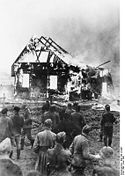
Poland
Poland , officially the Republic of Poland , is a country in Central Europe bordered by Germany to the west; the Czech Republic and Slovakia to the south; Ukraine, Belarus and Lithuania to the east; and the Baltic Sea and Kaliningrad Oblast, a Russian exclave, to the north...
and Lithuania
Lithuania
Lithuania , officially the Republic of Lithuania is a country in Northern Europe, the biggest of the three Baltic states. It is situated along the southeastern shore of the Baltic Sea, whereby to the west lie Sweden and Denmark...
, wooden synagogues are found in modern Belarus
Belarus
Belarus , officially the Republic of Belarus, is a landlocked country in Eastern Europe, bordered clockwise by Russia to the northeast, Ukraine to the south, Poland to the west, and Lithuania and Latvia to the northwest. Its capital is Minsk; other major cities include Brest, Grodno , Gomel ,...
and the Ukraine
Ukraine
Ukraine is a country in Eastern Europe. It has an area of 603,628 km², making it the second largest contiguous country on the European continent, after Russia...
.
Wood was abundant and inexpensive in the heavily forested commonwealth, but a large part of the motivation for building in wood rather than masonry was the great difficulty of obtaining government permission to erect masonry synagogues. The wooden synagogues, which featured multi-layered high roofs, multi-beamed domes, galleries, wooden balconies and arches were built to high standards of craftsmanship.
Interior decoration
The interiors were decorated with wall and ceiling paintings that, in many cases, covered the walls and ceilings entirely, and with elaborately carved wooden Torah Arks.Thomas Hubka
Thomas Hubka
Thomas C. Hubka is an American architectural historian whose primary focus is vernacular architecture and related issues of architecture and cultural meaning....
has traced the style of decorative painting in the wooden synagogues to the medieval Hebrew illuminated manuscripts of Ashkenazi Jewry.
The intricate wooden decoration of the barrel vault
Barrel vault
A barrel vault, also known as a tunnel vault or a wagon vault, is an architectural element formed by the extrusion of a single curve along a given distance. The curves are typically circular in shape, lending a semi-cylindrical appearance to the total design...
ed ceiling of the Przedbórz Synagogue
Przedbórz Synagogue
-History:A Jewish community is documented to have been established in Przedbórz by 1570. At the beginning of the Second World War, the town was 60% Jewish....
was considered so beautiful that before the Second World War it drew tourists to the small village of Przedbórz
Przedbórz
Przedbórz is a town in Radomsko County, Łódź Voivodeship, Poland, with 3,835 inhabitants . Przedbórz is situated on the Pilica River....
.
Regional variations
Architectural historian Rachel WischnitzerRachel Wischnitzer
Rachel Bernstein Wischnitzer , was an architect and art historian.-Biography:...
has traced regional variations in wooden synagogue style. The interiors of the wooden synagogues of Lithuania
Lithuania
Lithuania , officially the Republic of Lithuania is a country in Northern Europe, the biggest of the three Baltic states. It is situated along the southeastern shore of the Baltic Sea, whereby to the west lie Sweden and Denmark...
were not as exuberantly painted as were synagogues of other regions. Instead, Lithuanian synagogues were notable for architectural details such as ceilings with the boards laid in decorative herringbone patterns. Several Lithuanian synagogues featured corner pavilions. The wooden synagogues of Galicia were notable for their elaborate wall paintings.
Influence on art and architecture
Frank StellaFrank Stella
Frank Stella is an American painter and printmaker, significant within the art movements of minimalism and post-painterly abstraction.-Biography:...
's Polish village series draws on images of Wooden synagogues published by Maria and Kazimierz Piechotkain in their 1957 book, Wooden synagogues.
The Sons of Israel Synagogue, by architects Davis, Brody and Wisniewski, in Lakewood, New Jersey evokes Polish wooden synagogues in modern materials in the shape of its roof. The Temple B'rith Kodesh
Temple B'rith Kodesh
Temple B'rith Kodesh is a Reform synagogue in Rochester, New York. It is the oldest synagogue and the largest Reform congregation in the greater Rochester area.-History:Temple B'rith Kodesh was founded in 1848 as an Orthodox congregation with 12 members...
in Rochester, New York
Rochester, New York
Rochester is a city in Monroe County, New York, south of Lake Ontario in the United States. Known as The World's Image Centre, it was also once known as The Flour City, and more recently as The Flower City...
, by architect Pietro Belluschi
Pietro Belluschi
Pietro Belluschi was an American architect, a leader of the Modern Movement in architecture, and was responsible for the design of over one thousand buildings....
is roofed with a domed wooden drum intended to evoke the wooden synagogues of Poland. The modern building of Congregation Beth Shalom Rodfe Zedek
Beth Shalom Rodfe Zedek
Beth Shalom Rodfe Zedek is a Reform synagogue in Chester, Connecticut. The congregation is noted for the architecture of its "spectacular" building.-History:Congregation Rodfe Zedek in Moodus, Connecticut in 1905...
in Chester, Connecticut
Chester, Connecticut
Chester is a town in Middlesex County, Connecticut, United States. The population was 3,743 at the 2000 census. The town center is also defined by the U.S. Census Bureau as a census-designated place .-Geography:...
was designed by artist Sol LeWitt
Sol LeWitt
Solomon "Sol" LeWitt was an American artist linked to various movements, including Conceptual art and Minimalism....
who conceptualized the "airy" synagogue building, with its shallow dome supported by "exuberant wooden roof beams" an homage to the Wooden synagogues of eastern Europe.
Surviving wooden synagogues
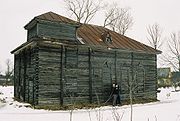
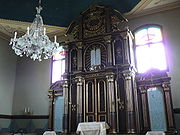
Surviving examples include:
- PakruojisPakruojisPakruojis is a city in Lithuania. It is situated on the Kruoja River, which has a dam above the city. 43 buildings of the manor, mentioned in 1531, survived to this day....
, the largest of the wooden synagogues that survives in present day Lithuania (built 1801), now in deteriorating condition - TirkšliaiTirkšliaiTirkšliai is a town in Telšiai County, Lithuania. According to the 2001 census, the town has a population of 1626 people....
- ŽiežmariaiŽiežmariaiŽiežmariai is a city in the Kaišiadorys district municipality, Lithuania. It is located south of Kaišiadorys.Žiežmariai has a rare, surviving wooden synagogue.-References:...
, in deteriorating condition - TelšiaiTelšiaiTelšiai , is a city in Lithuania with about 35,000 inhabitants. It is the capital of Telšiai County and Samogitia region, and it is located on Lake Mastis.-Names:...
, built in 19th century, vacated around 1940 - KurkliaiKurkliaiKurkliai is a town in Anykščiai district municipality, in Utena County, in northeast Lithuania. According to the 2001 census, the town has a population of 474 people. Center of eldership. In town there is Anykščiai Regional Park....
, in Soviet timesLithuanian SSRThe Lithuanian Soviet Socialist Republic , also known as the Lithuanian SSR, was one of the republics that made up the former Soviet Union...
used as barn, now in deteriorating condition - AlantaAlantaAlanta is a small town in Molėtai district municipality, Lithuania. It is the administrative seat of the Alanta Elderate. According to a census in 2001, Alanta had 464 residents. It is situated at the crossing of two roads: Molėtai–Anykščiai and Utena–Alanta–Ukmergė. The town's St...
, built in late 19th century, in deteriorating condition - RozalimasRozalimasRozalimas is a small town in Šiauliai County in northern-central Lithuania. As of 2001 it had a population of 928.-References:*This article was initially translated from the Lithuanian Wikipedia....
, built in 19th century - KaltinėnaiKaltinenaiKaltinėnai is a little town on the west side of Lithuania, near Žemaičių highroad, Šilalė district municipality.In Kaltinėnai live about 1000 inhabitants. The town is in a hollow. People say that in the end of Ice age here was a big lake. There are many breathtaking views around Kaltinėnai...
(in CommonwealthPolish-Lithuanian CommonwealthThe Polish–Lithuanian Commonwealth was a dualistic state of Poland and Lithuania ruled by a common monarch. It was the largest and one of the most populous countries of 16th- and 17th‑century Europe with some and a multi-ethnic population of 11 million at its peak in the early 17th century...
gminaGminaThe gmina is the principal unit of administrative division of Poland at its lowest uniform level. It is often translated as "commune" or "municipality." As of 2010 there were 2,479 gminas throughout the country...
Szyłele) - LaukuvaLaukuvaLaukuva is a town in Taurage County, Lithuania. According to the 2001 census, the town has a population of 998 people....
- VeisiejaiVeisiejaiVeisiejai is a city in the Lazdijai district municipality, Lithuania. It is located south-east of Lazdijai. The Esperanto language was created in Veisiejai where L. L. Zamenhof started his practice as an ophtalmologist in 1885. There is a church dedicated to St...
- TrakaiTrakaiTrakai is a historic city and lake resort in Lithuania. It lies 28 km west of Vilnius, the capital of Lithuania. Because of its proximity to Vilnius, Trakai is a popular tourist destination. Trakai is the administrative centre of Trakai district municipality. The town covers 11.52 km2 of...
, a Karaite synagogue called KenesaKenesaKenesa is the term for a Karaite or Persian synagogue. The word derives from the Aramaic word for "assembly" .-Layout:...
built in 18th century, with altarAltarAn altar is any structure upon which offerings such as sacrifices are made for religious purposes. Altars are usually found at shrines, and they can be located in temples, churches and other places of worship...
(Torah Ark) and interior preserved in good condition - SubateSubateSubate , population 964, is a town in Latvia near the border with Lithuania. Subate is located in Selonia, the eastern part of the Zemgale region, 40 km west of Daugavpils....
(Latvia)
Destroyed in the 21st century:
- SedaSedaSeda is a city in Mažeikiai district municipality, Lithuania. It is located south-west of Mažeikiai on the Varduva River. There are two churches in the town.- History :...
, built in early 20th century , collapsed in 2005 - PlungėPlungePlungė is a city in Lithuania with 23,246 inhabitants. It has a crab stick factory which exports to many countries in Europe.Before World War II, Plunge had a large Jewish population.- History :...
, brought down in 2007
See also
- History of the Jews in PolandHistory of the Jews in PolandThe history of the Jews in Poland dates back over a millennium. For centuries, Poland was home to the largest and most significant Jewish community in the world. Poland was the centre of Jewish culture thanks to a long period of statutory religious tolerance and social autonomy. This ended with the...
- History of the Jews in LithuaniaHistory of the Jews in LithuaniaThe history of the Jews in Lithuania spans the period from the eighth century to the present day. There is still a small community in that country, as well as an extensive Lithuanian Jewish diaspora in Israel, the United States and other countries. For more detail, see Lithuanian Jews.-Early...
- History of the Jews in Galicia (Central Europe)
- History of the Jews in UkraineHistory of the Jews in UkraineJewish communities have existed in the territory of Ukraine from the time of Kievan Rus' and developed many of the most distinctive modern Jewish theological and cultural traditions. While at times they flourished, at other times they faced periods of persecution and antisemitic discriminatory...
- Three haresThree haresThe three hares is a circular motif appearing in sacred sites from the Middle and Far East to the churches of southwest England , and historical synagogues in Europe....
- Vernacular architecture of the CarpathiansVernacular architecture of the CarpathiansThe vernacular architecture of the Carpathians draws on environmental and cultural sources to create unique designs.Vernacular architecture refers to non-professional, folk architecture, including that of the peasants...
Further reading
- Resplendent Synagogue: Architecture and Worship in an Eighteenth Century Polish Community, by Thomas C. Hubka, Brandeis University Press, 2003
- Heaven’s Gate: Wooden Synagogues in the Territory of the Former Polish-Lithuanian Commonwealth, by Maria and Kazimierz Piechotka, Institute of Art, Polish Academy of Sciences, Wydawnnictwo Krupski I S-ka, Warsaw, 2004
- Wooden Synagogues, By Maria Piechotka, Kazimierz Piechotka, Politechnika Warszawska Zakład Architektury Polskiej, Published by Arkady, 1957 in Polish, 1959 in English

